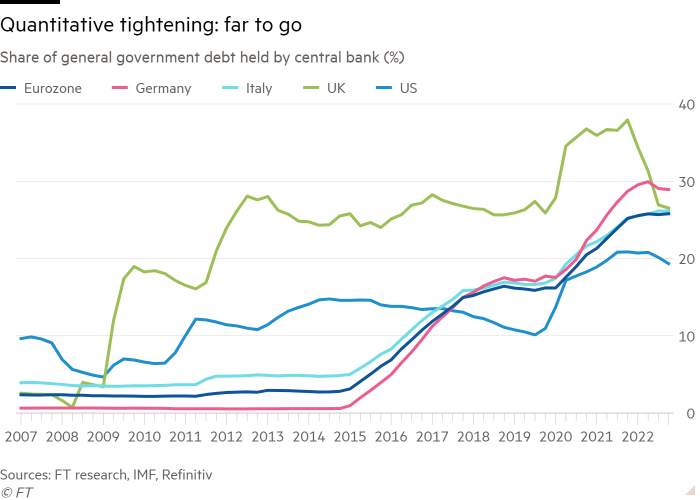Receive free Central banks updates
We’ll send you a myFT Daily Digest email rounding up the latest Central banks news every morning.
European central banks could accelerate the process of shrinking their vast bond portfolios, according to officials and economists, who say this would reinforce their fight against inflation and make room to buy assets again in the next crisis.
Rate rises have been the main tool for central banks to tackle the recent surge in inflation and both the US Federal Reserve and European Central Bank are expected to lift rates again this week, while the Bank of England looks set to follow suit next month.
But they have also begun cutting their bond holdings in a process known as quantitative tightening, which shrinks the size of their balance sheets. The ECB and BoE still hold more than a quarter of their governments’ outstanding debt, while the Fed holds a fifth, according to data analysis by the Financial Times.
This QT process, which started last year, has so far gone relatively smoothly with few signs of disruption in bond markets. This is giving economists and some senior central bank officials more confidence that it could be accelerated, particularly in Europe.
Mark Wall, chief economist at Deutsche Bank, said “it would be reasonable for the ECB to start thinking about the next step in the gradual unwind of the expanded balance sheet”, adding that this “could be a strategy to reinforce the credibility of further rate hikes”.
Paul Hollingsworth, chief European economist at BNP Paribas, said: “While we do not think that a decision is imminent, more hawkish ECB members might be willing to accept a lower terminal rate if it allows QT to be accelerated.”
Tomasz Wieladek, chief European economist for fixed income at T Rowe Price, said that QT was “another way of taking demand out of the economy”.
He added: “Central banks don’t like to talk about it because there’s a fine line between monetary and fiscal policy. If they used it more forcefully as an instrument it could work.”

At the ECB’s annual conference in Sintra, Portugal, last month one rate-setter told the FT it could soon discuss the possibility of actively selling some bonds before they mature. German central bank boss Joachim Nagel said in March that “at a later stage” this year the ECB could also consider a faster shrinkage of a separate €1.7tn bond-buying programme it launched in response to the pandemic.
Jens Eisenschmidt, chief Europe economist at Morgan Stanley, predicted the central bank could start shrinking this pandemic emergency purchase programme in January next year and completely stop reinvestments by July, which would reduce it by €133bn in 2024. “All the evidence so far suggests there is no reason they can’t go faster,” he said.
Dave Ramsden, the BoE’s deputy governor for markets and banking, said last week that the central bank could quicken the pace of QT after September, because its experience had proved it was possible for the exercise to operate “in the background” and has not had a big economic impact.
By contrast, the US Fed has shown no sign of planning to adjust that: inflation has fallen faster in the US than in Europe, and it has reason to be cautious on liquidity levels in financial markets. In 2019, the Fed was forced to halt QT after a $750bn reduction in its asset holdings in two years caused a jump in short-term funding costs.
The Fed’s balance sheet peaked in April 2022 just shy of $9tn and has shrunk by roughly $850bn, according to calculations from Scott Skyrm, a repo trader at Curvature Securities.
Praveen Korapaty, chief global rates strategist at Goldman Sachs, said the Fed could plough forward with QT this year and into 2024 without any issues given the financial system was “pretty far” from any kind of crunch point. However, he warned that an uneven distribution of bank reserves could mean certain institutions were facing more immediate pressures than others.
“I’m very confident system-wise we are still saturated with liquidity . . . but it might not be the most useful distribution in the sense that clearly there are some small and midsize banks that are more constrained for reserves,” he said.
The collapse of several lenders including Silicon Valley Bank earlier this year was a warning against overtightening financial conditions, some analysts said.
“Before SVB happened, many at the Fed probably felt comfortable really pressing the issue on QT and seeing how low they could run the balance sheet,” said Blake Gwinn, head of rates strategy at RBC. “If we see any kind of hiccups or any kind of signs that banks are starting to become a little scarce on reserves, there is going to be a bit more anxiety there and they are going to be quicker to pull the trigger on ending QT.”
Stepping up QT could help rebalance the distributional impacts of monetary policy tightening, Wieladek argued: “Policy rates remain the main instrument but it’s not clear that this is the best thing to do, especially if you end up pushing all the monetary adjustment on just one actor in the economy”, such as mortgage holders.
But, he warned, the process carried risks: “There is a risk that we don’t know the consequences of QT. [It] may be non-linear so the cost of government borrowing suddenly rises significantly.”
“This is uncharted territory for many of the world’s major central banks,” said Ashok Bhatia, the IMF director of offices in Europe. “On balance, we think the approach adopted thus far is appropriate, with room for periodic reassessments of the pace in the future.”
Stay connected with us on social media platform for instant update click here to join our Twitter, & Facebook
We are now on Telegram. Click here to join our channel (@TechiUpdate) and stay updated with the latest Technology headlines.
For all the latest Business News Click Here
For the latest news and updates, follow us on Google News.
